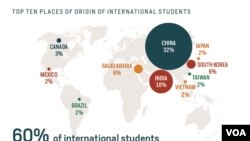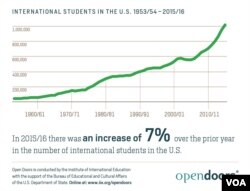Nearly four in 10 U.S. colleges and universities have reported a decline in international student applications, according to a recent survey by six higher education groups.
The study of 250 American colleges and universities found the highest number of declines were from applicants from the Middle East.
Universities report declines of 39 percent in undergraduate applications from the Middle East, while applications from graduate students from the region have decreased by 31 percent.
According to the Institute of Higher Education, the majority of Middle East students are from Saudi Arabia, Iran and Kuwait.
Iran, which accounted for over 12,000 international students for the 2015/2016 academic year, is one of six countries where U.S. President Donald Trump’s has instituted a temporary ban on travelers.
The report does not say this is a direct cause for the decrease, but mentions that according to institution-based professionals “perceptions that the climate in the U.S. is now less welcoming to individuals from other countries” is one of the “most frequently noted concerns of international students and their families.”
India and China, which together make up 47 percent of international student enrollment, also have been impacted. Twenty-six percent of colleges have reported declining undergraduate applications from India while 25 percent say they have seen a decline in those from China.
Portland State University president Wim Wiewel says his school saw a 37 percent reduction in applications from India for the fall school year.
Weiwel says that while some of the decrease were due to monetary changes in India that make an American education more expensive, some parents are worried about their children’s safety following a recent racially motivated attack on two Indian engineers that left one dead in Kansas.
“I tried to reassure them that America is still very safe and very welcoming to international students,” he said.
International students account for 1,900 of Portland State’s school’s nearly 28,000 students. Students from outside Oregon pay about three times the $8,000 tuition paid by state residents. Wiewel says the extra money helps the school improve its educational offerings.
More than 1 million international students come to the United States to attend colleges and universities. The majority are from China, with over 300,000 nationals studying, followed by India where over 160,000 students hail.
Although one of the top destinations for international students, U.S. universities and colleges face stiff competition from schools in Britain, Canada, France and Australia which each attract a significant number of applicants.
International students added $32.8 billion to the U.S. economy last year.
The international student survey was conducted in February by the American Association of Collegiate Registrars and Admissions Officers (AACRAO), the Institute of International Education (IIE), the Association of International Educators (NAFSA), the National Association for College Admission Counseling (NACAC), and the International Association for College Admission Counseling (ACAC).
Full results from the study will be released later this month.
VOA Learning English contributed to this report.
Did you want to come to school in the U.S., but decided against it? Please tell us why in the Comments, and visit us on Facebook, Twitter, Instagram and LinkedIn, thanks!
The study of 250 American colleges and universities found the highest number of declines were from applicants from the Middle East.
Universities report declines of 39 percent in undergraduate applications from the Middle East, while applications from graduate students from the region have decreased by 31 percent.
According to the Institute of Higher Education, the majority of Middle East students are from Saudi Arabia, Iran and Kuwait.
Iran, which accounted for over 12,000 international students for the 2015/2016 academic year, is one of six countries where U.S. President Donald Trump’s has instituted a temporary ban on travelers.
The report does not say this is a direct cause for the decrease, but mentions that according to institution-based professionals “perceptions that the climate in the U.S. is now less welcoming to individuals from other countries” is one of the “most frequently noted concerns of international students and their families.”
India and China, which together make up 47 percent of international student enrollment, also have been impacted. Twenty-six percent of colleges have reported declining undergraduate applications from India while 25 percent say they have seen a decline in those from China.
Portland State University president Wim Wiewel says his school saw a 37 percent reduction in applications from India for the fall school year.
Weiwel says that while some of the decrease were due to monetary changes in India that make an American education more expensive, some parents are worried about their children’s safety following a recent racially motivated attack on two Indian engineers that left one dead in Kansas.
“I tried to reassure them that America is still very safe and very welcoming to international students,” he said.
International students account for 1,900 of Portland State’s school’s nearly 28,000 students. Students from outside Oregon pay about three times the $8,000 tuition paid by state residents. Wiewel says the extra money helps the school improve its educational offerings.
More than 1 million international students come to the United States to attend colleges and universities. The majority are from China, with over 300,000 nationals studying, followed by India where over 160,000 students hail.
Although one of the top destinations for international students, U.S. universities and colleges face stiff competition from schools in Britain, Canada, France and Australia which each attract a significant number of applicants.
International students added $32.8 billion to the U.S. economy last year.
The international student survey was conducted in February by the American Association of Collegiate Registrars and Admissions Officers (AACRAO), the Institute of International Education (IIE), the Association of International Educators (NAFSA), the National Association for College Admission Counseling (NACAC), and the International Association for College Admission Counseling (ACAC).
Full results from the study will be released later this month.
VOA Learning English contributed to this report.
Did you want to come to school in the U.S., but decided against it? Please tell us why in the Comments, and visit us on Facebook, Twitter, Instagram and LinkedIn, thanks!






